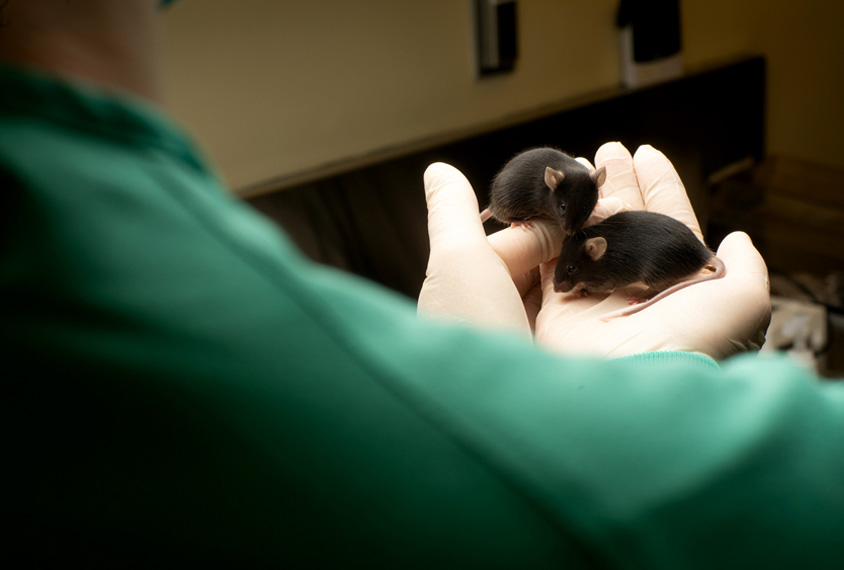Mice with a mutation in an autism-linked gene called ADNP show sex-specific changes in gene expression, behavior and other characteristics, a new study shows. The mice may mimic some of the traits seen in people with ADNP mutations more closely than a previously created mouse strain.
Mutations in ADNP cause a syndrome characterized by autism, intellectual disability, distinctive facial features and low muscle tone. An earlier mouse model of this syndrome lacked one copy of the gene. To create the new model, the same team used CRISPR to create animals with what is the most common ADNP mutation in people.
Both sexes of the new model have delayed development and social difficulties — among other things, with male pups also showing brain deposits of tau protein, which is involved in Alzheimer’s disease. Giving the animals an intranasal treatment of short ADNP protein fragments alleviated many of these traits, offering hope for treating children with ADNP mutations.
“[The new model] can help us to understand how to manage the condition in humans,” says Albert Pinhasov, professor of behavioral and molecular psychiatry at Ariel University in the West Bank, who was not involved in the study. Because people with ADNP syndrome vary in the type of mutation they have, he notes, “it would be useful to develop additional CRISPR-based models with other mutations.”
The mice may also help researchers identify biological signatures of the syndrome, says lead investigator Illana Gozes, professor emerita of clinical biochemistry at Tel Aviv University in Israel.
Model behavior:
The mice produce a mutated form of ADNP protein, plus half the typical amount of functional ADNP protein.
Pups with mutated ADNP squeaked with overly simple call sequences and did not startle as easily as controls in response to sounds, suggesting that their hearing development is delayed. Animals with mutated ADNP also had unusual walking patterns and other motor difficulties, which were more pronounced in female mice.
Compared with controls, ADNP mice of both sexes showed no preference for another mouse over an object, and they were slower to leave a metal plate they stood on as it warmed, which suggests problems with sensory development. Male mice also groomed more frequently and for longer periods than controls did, a trait reminiscent of repetitive behaviors in people.
Male ADNP mice had trouble recognizing an object and showed abnormal brain responses after viewing a visual stimulus. By the time the males were 2 months old, their brains were riddled with deposits of tau, which Gozes’ team has previously found in elderly mice missing one copy of ADNP and in postmortem brain tissue from a boy with ADNP syndrome.
Treating the animals with an eight-amino-acid fragment of the ADNP protein, called NAP, lessened the deposits and eased other traits, the researchers found.
Treatment with NAP also corrected alterations in the expression of five major genes that were commonly deregulated in female ADNP mice. The genes include FOXO3, which is important for the formation of dendritic spines, the neuronal projections that receive electrical signals from other cells.
Cells derived from people with ADNP mutations show altered expression of the same genes, which could be used as biomarkers of ADNP syndrome, Gozes says. The findings were published in September in Biological Psychiatry.
Translational value:
Because a mouse’s genetic background may have a significant influence on its behavior and biology, assessing the impact of specific ADNP mutations in different mouse strains may offer more clarity on the role of individual gene variants, says Nicola Grissom, assistant professor of psychology at the University of Minnesota in Minneapolis, who was not involved in the research.
The study highlights how multiple mechanisms can influence biology, Grissom says. About four times as many boys as girls are diagnosed with autism, but it’s still unclear whether the higher prevalence of autism in boys is driven by ascertainment bias or sex-specific differences that influence brain development, she says. “People are looking at whether there might be differences across male and female animals in the impact of genotype, and they’re discovering that indeed there may be untapped ones.”
Some of the study’s findings could also have translational potential. NAP has been previously tested in clinical trials for schizophrenia, mild cognitive impairment and other brain conditions. Although these trials had mixed success, they showed that the peptide is generally safe, which led Gozes and others to speculate that it could be used to treat people with ADNP mutations.
“NAP is ready for clinical trials [for ADNP syndrome],” says Haitham Amal, assistant professor of neuromics, cell signaling and translational medicine at the Hebrew University of Jerusalem in Israel, who was not involved in the study.
The main obstacle to testing NAP in clinical trials for ADNP syndrome is funding, Gozes says, but the technology transfer arm of Tel Aviv University, which holds intellectual property rights on the peptide, is raising money to bring NAP into clinical practice and is ready to license it to drug development companies.






